2024 Pivot Switchblade
Wheel Size: 29’’; compatible with 27.5’’ rear wheel
Travel: 142 mm rear / 160 mm front
Geometry Highlights:
- Sizes offered: XS, Small, Medium, Large, XL
- Headtube angle: 65.2° / 65.7° (adjustable, see below)
- Reach: 465 mm (size Medium)
- Chainstay length: 431 mm (Size Medium)
Frame Material: Carbon Fiber
Price: Complete bikes $6,399 to 11,599 USD
Size Tested: Medium
Blister’s Measured Weight: 31.2 lbs (14.15 kg) without pedals
Reviewer: 5’9”, 170 lbs (175 cm, 77.1 kg)
Test Location: Montana
Test Duration: ~2 months

Intro
The Switchblade has been in Pivot’s lineup for quite a while now (and Pivot founder Chris Cocalis has an even longer track record with the name, dating back to his prior company, Titus). As the name might suggest, the Switchblade has been intended to be a super versatile all-rounder Trail bike.
With the latest version, announced today, Pivot hasn’t seriously changed the way that they describe the new Switchblade. As they put it, the Switchblade is the “definitive do-it-all mountain bike, up for everything from ‘singletrack to bike park, from flow to chunk, from pain cave climb to ragged edge, full-gas descent.’” That’s a wide range of use cases, so how has Pivot gone about making a bike to cover all those bases, and how does it compare (on paper) to the outgoing model? Let’s take a look.

The Frame
The prior-generation Switchblade was one of the first bikes to get Pivot’s current vertically oriented shock layout, and the overall lines of the new one have barely changed from those of its predecessor. (Hats off to Pivot’s design team for making something that still looks modern on a bike that was unveiled four years ago.) As per usual for Pivot, the Switchblade frame is offered in carbon fiber only.
The Switchblade is still a 142mm-travel bike that gets that travel via a DW-Link suspension design, and is built around a 160mm-travel fork, too. Pivot’s preferred Super Boost spacing is still here, though the Switchblade now features a UDH for SRAM Transmission compatibility.
Most of the other design details are in keeping with what we’re used to from Pivot. The cable routing is internal; there’s a water bottle mount inside the front triangle; they add accessory mounts for Pivot’s Dock tool system under both the top tube and down tube; and there are ample rubber guards on the chainstay, seat stay, and the underside of the downtube.
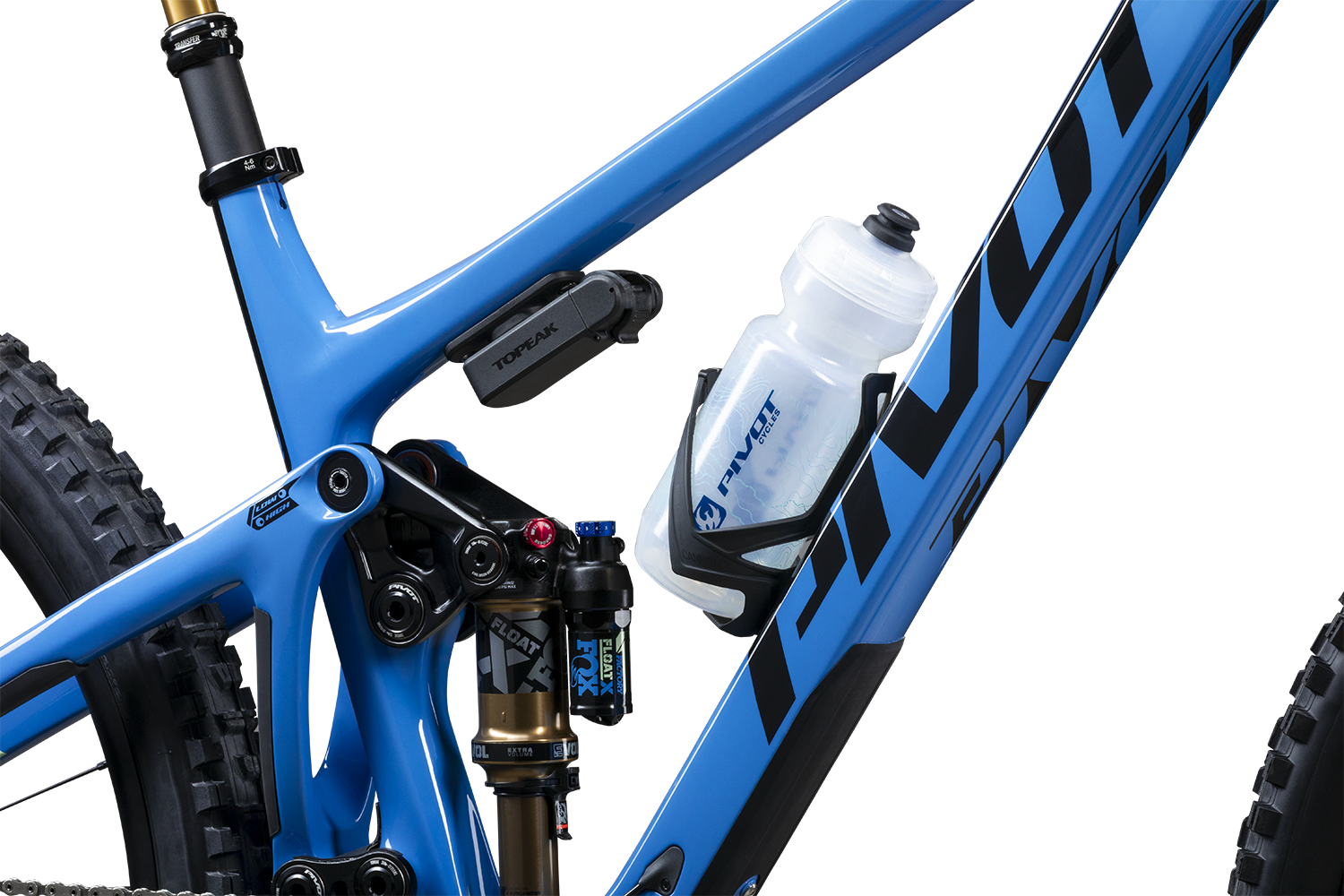
While the overall suspension layout hasn’t changed from the prior-generation Switchblade, Pivot says that they have tweaked the kinematics a bit, seemingly with a focus on improving downhill performance. The details of what changed aren’t specified, but Pivot says they’ve drawn on what they learned from developing the current Firebird to improve the more aggressive descending side of the Switchblade’s capabilities.
Fit & Geometry
Given that the prior-generation Switchblade had been around for about four years now, it’s no great surprise that Pivot has made the new one a bit longer and slacker — but the changes they made aren’t wildly dramatic, either.
The Switchblade is offered in the same five sizes, XS, S, M, L, and XL; the reach on the XS has held steady at 410 mm, but the other sizes have all grown by 10 mm (440 mm on the Small through 500 mm on the XL), while the headtube has been slackened by 0.8°, to 65.2°. The seat tube has gotten a touch steeper (76° effective on XS through Large frames; 76.5° on the XL), and the stack height has been increased a little bit across the board, too (to 638 mm on the Medium).
Those numbers are all in the low geometry position, which produces a 29 mm bottom bracket drop to round things out; the high setting raises the bottom bracket by 6 mm, steepens the angles by 0.5°, and adds 5 mm to the reach figures while subtracting a similar amount from the stack heights.

The other notable change is that the Switchblade now features size-specific chainstay lengths, though they’re mostly pretty subtle. The XS, Small, and Medium frames all share the same 431 mm length that the prior-generation bike used across the size range; the Large bumps that up ever so slightly to 432 mm, with the only really big change happening on the XL, which grows to 436 mm.
Those all seem like pretty normal numbers for what’s meant to be a versatile all-rounder of a bike — probably in a good way. Pivot also says that the Switchblade can be run in a mixed-wheel configuration in its high geometry setting, but don’t publish a geometry chart for that particular setup.
The Builds
Pivot offers the Switchblade in six total build specs, following their standard Ride / Pro / Team tiers, with a SRAM and Shimano drivetrain / brake option at each level. As per usual for Pivot, Fox handles the suspension irrespective of the drivetrain brand, and the Pro-level builds have an optional carbon fiber wheel upgrade. All the builds come with 29’’ wheels at both ends, shod in Maxxis Minion DHF front / DHRII rear tires (the rubber compounds and casings are specified, but appear to be 3C MaxxTerra / Exo+ at both ends).
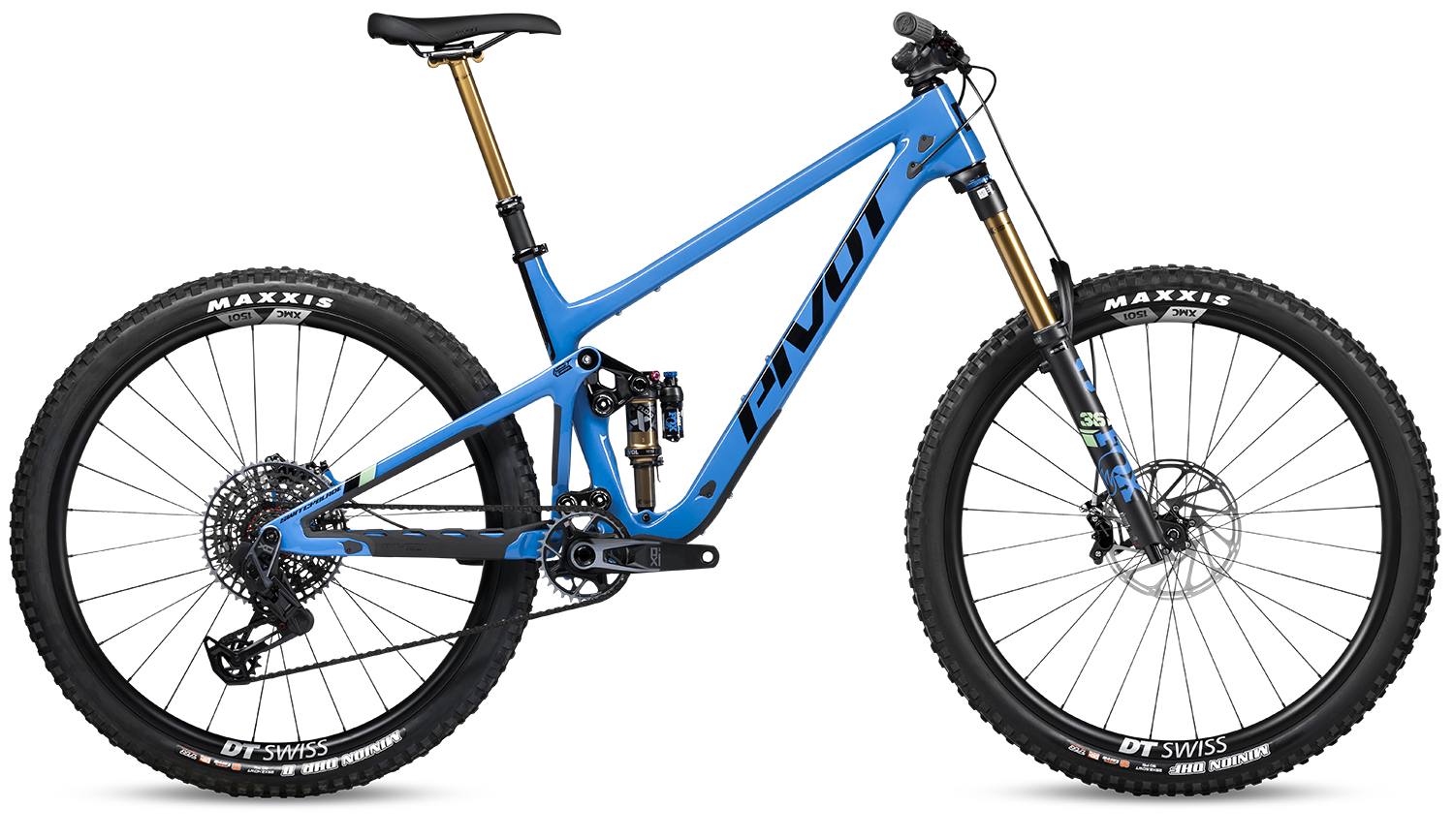
- Drivetrain: Shimano SLX w/ XT rear derailleur
- Cranks: Race Face Ride
- Brakes: Shimano SLX 4-piston (w/ 203 mm front / 180 mm rear rotors)
- Fork: Fox 36 Performance
- Shock: Fox Float X Performance
- Wheels: DT Swiss M1900
- Dropper Post: Fox Transfer Performance Elite (XS: 125 mm; S: 150 mm; M: 175 mm; L & XL: 200 mm)
- Drivetrain: SRAM GX T-Type
- Cranks: SRAM GX T-Type
- Brakes: SRAM Code R (w/ 200 mm front / 180 mm rear rotors)
- Fork: Fox 36 Performance
- Shock: Fox Float X Performance
- Wheels: DT Swiss M1900
- Dropper Post: Fox Transfer Performance Elite (XS: 125 mm; S: 150 mm; M: 175 mm; L & XL: 200 mm)
- Drivetrain: Shimano XT w/ XTR rear derailleur
- Cranks: Race Face AEffect R
- Brakes: Shimano XT 4-piston (w/ 203 mm front / 180 mm rear rotors)
- Fork: Fox 36 Factory
- Shock: Fox Float X Factory
- Wheels: DT Swiss XM1700
- Upgrade: DT Swiss XMC1501 Carbon (+$1,200)
- Dropper Post: Fox Transfer Factory (XS: 125 mm; S: 150 mm; M: 175 mm; L & XL: 200 mm)
- Drivetrain: SRAM X0 T-Type
- Cranks: SRAM X0 T-Type
- Brakes: SRAM Code RSC (w/ 200 mm front / 180 mm rear rotors)
- Fork: Fox 36 Factory
- Shock: Fox Float X Factory
- Wheels: DT Swiss XM1700
- Upgrade: DT Swiss XMC1501 Carbon (+$1,200)
- Dropper Post: Fox Transfer Factory (XS: 125 mm; S: 150 mm; M: 175 mm; L & XL: 200 mm)
- Drivetrain: Shimano XTR
- Cranks: Race Face Next R
- Brakes: Shimano XTR 4-piston (w/ 203 mm front / 180 mm rear rotors)
- Fork: Fox 36 Factory
- Shock: Fox Float X Factory
- Wheels: DT Swiss XMC1501 Carbon
- Dropper Post: Fox Transfer Factory (XS: 125 mm; S: 150 mm; M: 175 mm; L & XL: 200 mm)
- Drivetrain: SRAM XX T-Type
- Cranks: SRAM XX T-Type
- Brakes: SRAM Code Ultimate Stealth (w/ 200 mm front / 180 mm rear rotors)
- Fork: Fox 36 Factory
- Shock: Fox Float X Factory
- Wheels: DT Swiss XMC1501 Carbon (+$1,200)
- Dropper Post: Fox Transfer Factory (XS: 125 mm; S: 150 mm; M: 175 mm; L & XL: 200 mm)
Pivot is also offering a limited-edition pink “Talon” paint option on the Switchblade, in homage to the Sun Eagle Talon that helped kickstart Pivot founder Chris Cocalis’ journey in bike design 35 years ago.

The limited-edition pink Talon paint is offered on the Pro and Team builds only. Its specs are the same as the standard builds, but with the carbon wheel upgrade applied by default on the Pro builds. The Talon edition also comes with a $200 price premium over the other paint options.
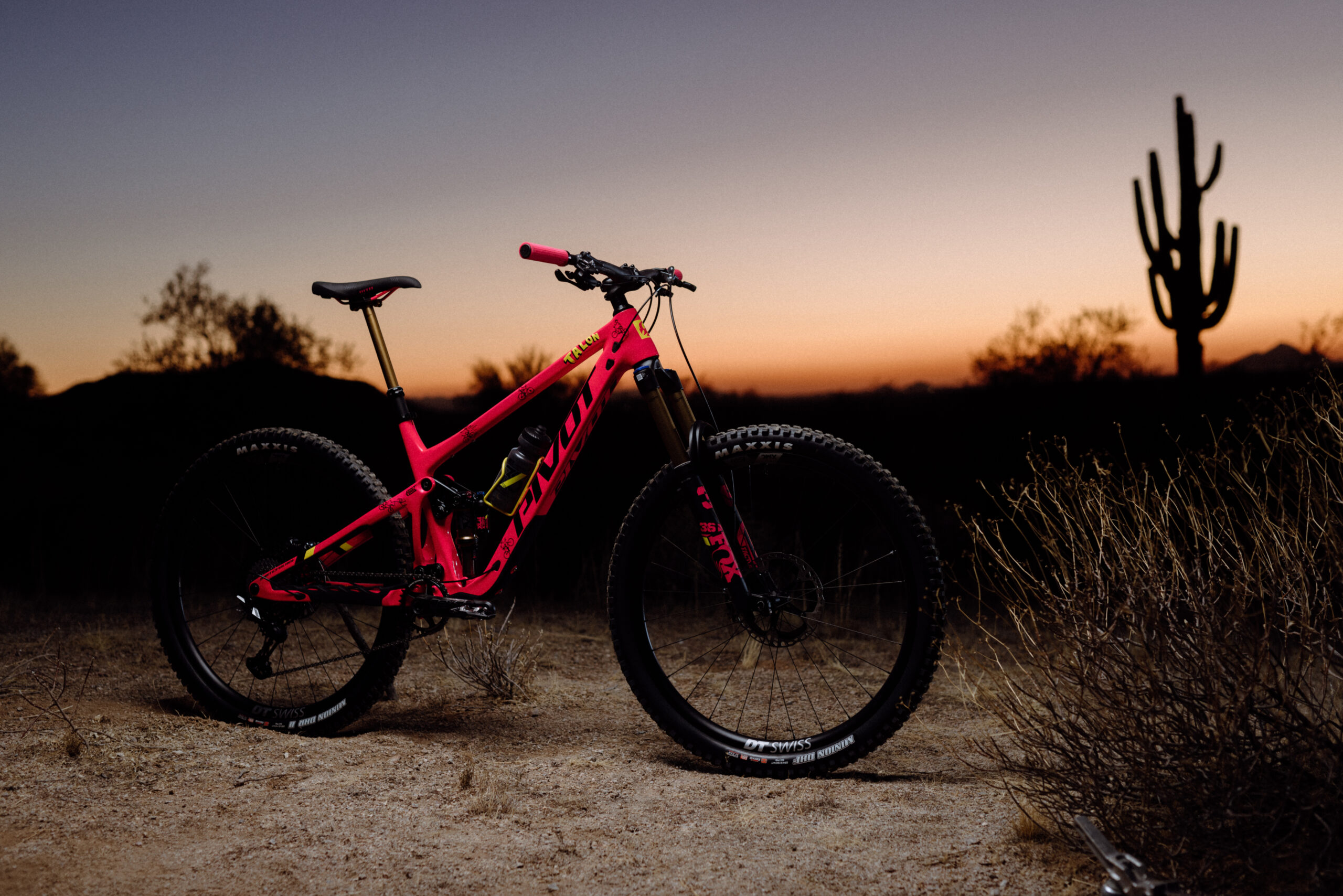
Some Questions / Things We’re Curious About
(1) Pivot’s description for the Switchblade covers a very wide range of uses — so where does it feel most at home, and just how versatile is it?
(2) And how does the Switchblade compare to a bunch of the other super-versatile mid-travel Trail bikes out there, including the Santa Cruz Hightower, Orbea Occam LT, Trek Fuel EX, and others?
FULL REVIEW
The Switchblade has been around for a while now, and for 2024, Pivot has released the third iteration of their mid-travel Trail bike. The 2024 Switchblade cuts a very similar profile to the prior generation, but it sees tweaks to the geometry and suspension kinematics. You’ll certainly be forgiven if the changes aren’t immediately obvious at a glance — the new Switchblade looks a whole lot like the old one. But looks can be deceiving, so we were curious to see how the new Switchblade would stack up.
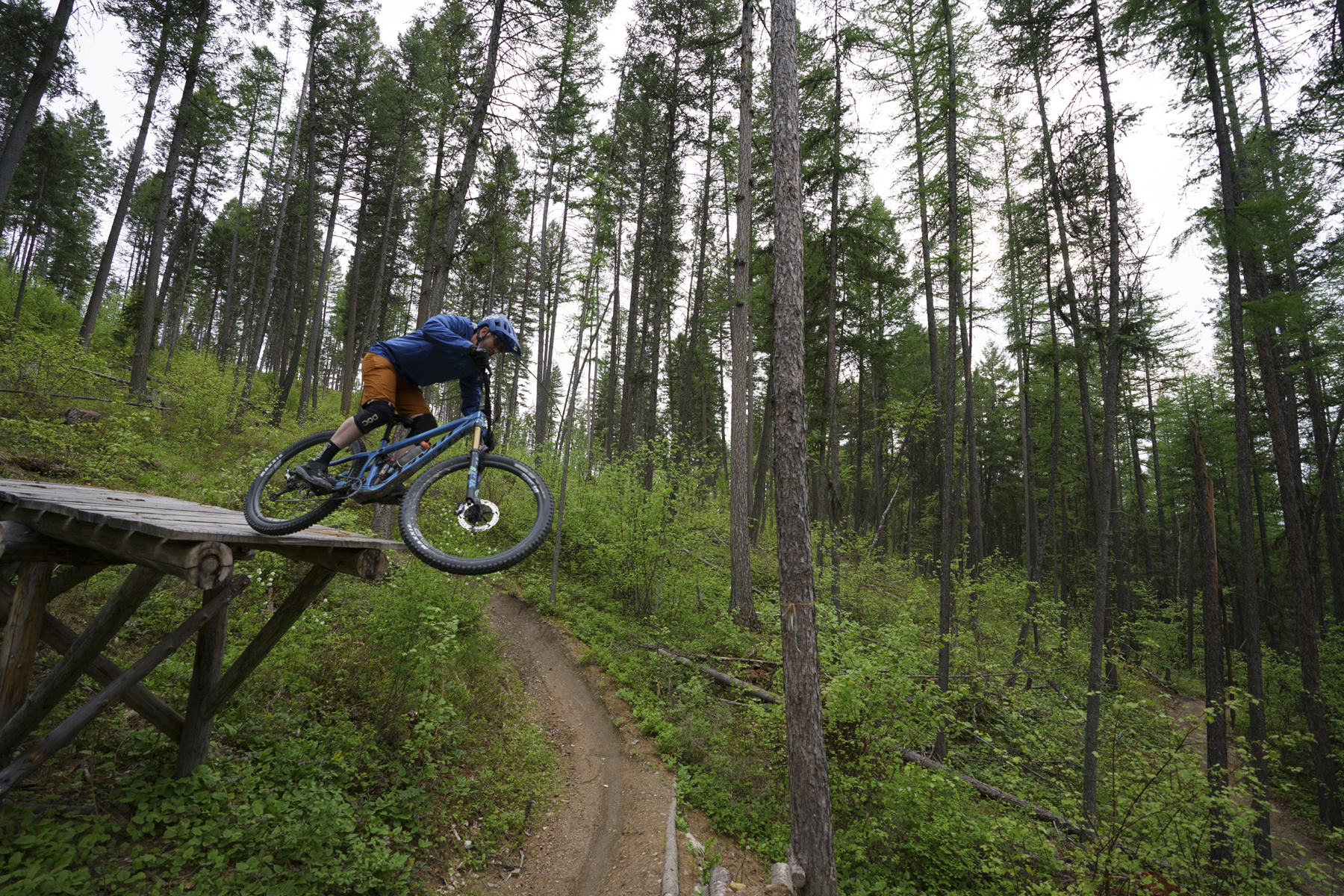
The Frame
As with all Pivots, the Switchblade is built around a DW Link suspension design, and as with all of the current generation Pivots (the production version of the Phoenix DH bike excepted), it gets a vertical shock orientation that creates a nice tidy front triangle with plenty of room for water bottles, tools, etc.
Details on the Switchblade are generally well thought out. The cable routing is internal, with guide tubes. It also has the nice touch of including a port for the rear brake on both sides of the headtube, so you get clean routing no matter which side of the bars your rear brake is on. The front triangle also gets three sets of bottle mounts: the traditional placement above the downtube, as well as on the underside of the downtube and the underside of the top tube (which won’t fit a bottle, but will accommodate tools or other smaller accesories).
That said, the Switchblade is lacking in-frame storage. That doesn’t really bother me, personally — it’s one less thing to rattle and / or break, but frame storage is the feature du jour, and some people will undoubtedly miss it.
The Switchblade has integrated protection on the drive side chainstay and seatstay, the bottom bracket area, and also via a little flap to keep mud and debris out of the lower linkage. That’s all pretty run of the mill these days, but the Switchblade’s protection worked well and kept chain slap noise to a minimum.
There’s a two-position flip chip built into the rocker link that allows for a modest steepening or slackening of the bike. I spent the majority of my time in slack / low mode and preferred the bike in that position, but going to high mode allows for fitting a 27.5” rear wheel for mullet mode while roughly maintaining the geometry of the full 29” setup in low mode.
On the whole, the Switchblade feels like a very well-put-together bike. Everything is neat, tidy, and well thought out. Even the paint was holding up well in my time on the bike. That said, there are two design choices on the frame that I have quibbles with.
First, the press-fit bottom bracket: it developed a creak during my time on the bike, and this is hardly the first press-fit bottom bracket to creak. I’d love to see a threaded bottom bracket in there.
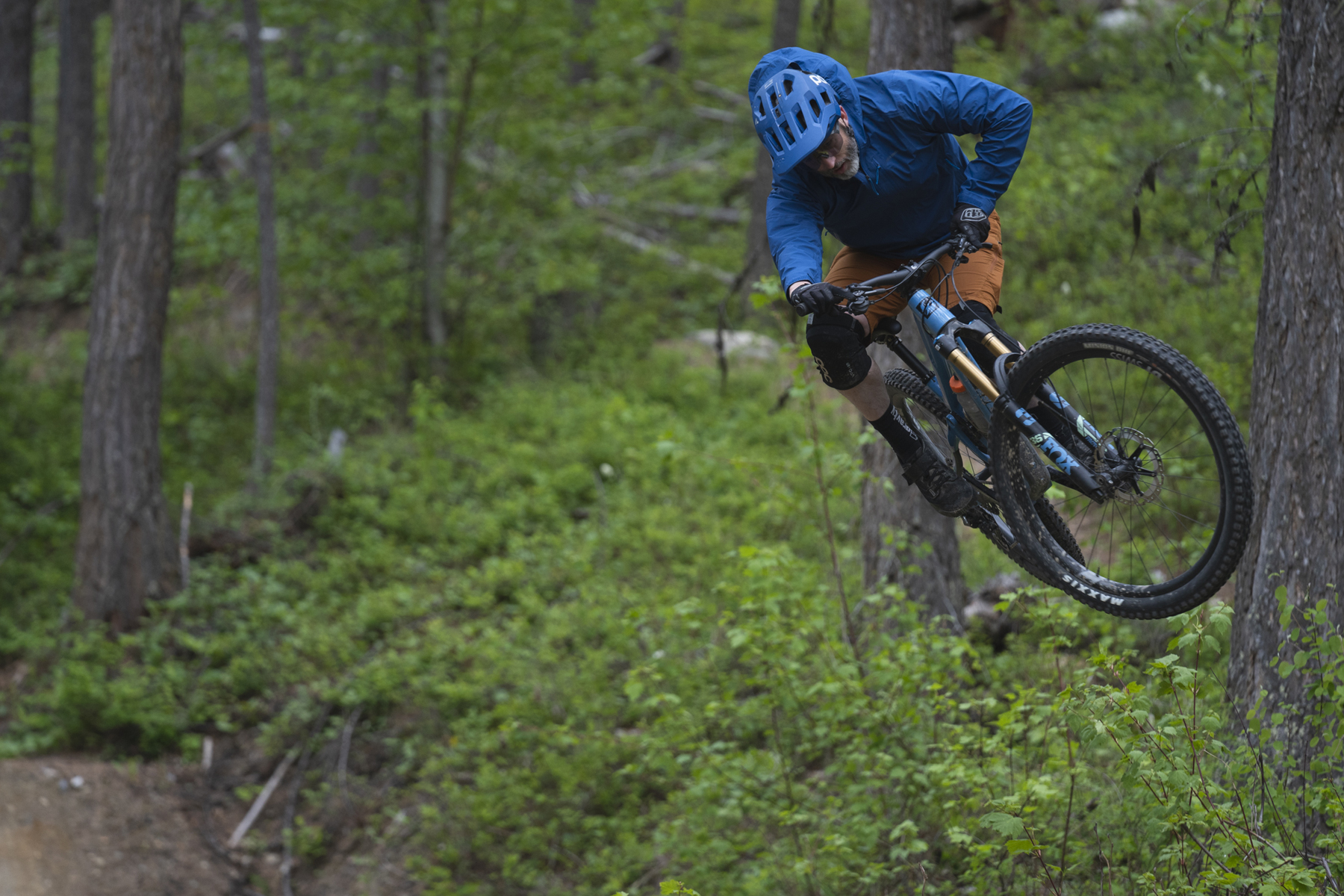
Second (and this one will be more contentious), I’m not a fan of Superboost spacing for the rear axle. The first generation of the Switchblade was offered with an option for plus-sized tires, and in that situation, Superboost made sense. But while the plus tire fad has died, Superboost lives on. Pivot has said that the Superboost rear end allows for a stronger, stiffer frame and wheel, but I question the necessity of adopting a more obscure standard when plenty of bikes (including bikes on the World Cup downhill circuit) seem to be faring just fine with regular boost spacing.
Fit & Sizing
I’d describe the Switchblade’s geometry as “conservatively modern.” It’s not particularly slack nor is the wheelbase particularly long, but it doesn’t feel outdated or anachronistic.
In terms of fit, the Switchblade is on the long side of average — I rode a size Medium, which has a 465 mm reach in low mode. For my 5’9” height with long arms and legs, I tend to prefer a reach in the 470-475 mm ballpark, and more often than not, that means a size Large from most brands. The Medium Switchblade, while slightly shorter than what I usually ride, seemed like the best bet for me; the size Large bumps up to a 480 mm reach, and more importantly, the effective top tube length stretches to 650 mm, which is too long for me on seated climbs. And sure enough, I felt entirely comfortable on the Medium Switchblade both for seated pedaling and while standing and descending, with a feel comparable to many of the size Larges I’ve ridden from other brands.
Elsewhere on the geometry chart, the Switchblade sticks to its Traill bike roots. A 65.2° head angle is perhaps ever so slightly steep these days, but not so steep that it raises eyebrows. A 76° seat tube is slacker than many of the more winch-and-plummet type bikes have, but it makes for a more comfortable ride (with less weight on the wrists) on flatter terrain.

One of the more noteworthy measurements on the Switchblade is its short chainstays. My size Medium has 431 mm stays (as do the Small and XS), while the Large bumps to 432 mm and the XL goes up to 436 mm. The sizing jumps for the larger sizes are small enough to be bordering on irrelevant (apart from maybe the step to the XL), and throughout the lineup, the stays are some of the shortest you’ll find on a modern 29” wheeled bike. That can be a good thing or a bad thing, depending on your preferences — more on that below.
Climbing
Before hitting dirt, I did my usual baseline suspension setup on the Switchblade, and I found the bike to be an easy one to get dialed. I ended up with 84 psi in the Fox 36 up front, and 170 psi in the rear (roughly my weight in pounds). That gave me a sag out back that was a smidge less than the recommended 30% — the Switchblade rode fine with a bit more sag, but I liked it better with a little less for a firmer, snappier feel. I played around with damper settings a bit, but on both the fork and rear shock I was generally hovering near the middle of the available adjustment range.
Out on the trail, what goes down must first go up, and in typical Pivot fashion, the Switchblade goes up really well. I’d call it one of the more efficient feeling bikes I’ve ridden in the 140-ish mm travel class. It cruises up smooth fire road climbs with minimal bob, and there’s just enough give in the suspension that it maintains decent traction on rougher climbs. Some other bikes are more active (and generally less efficient) for maximum traction and tech-climbing ability, but at least for the trails I ride, I found the Swtichblade’s climbing manners to be excellent. I didn’t touch the climb switch once in my time on the bike.
When the trail turns more vertical, the Switchblade’s short rear end and not ultra-steep seat tube mean that I found myself scooching up onto the nose of the saddle, but for more modest climbs I found the body position to be quite comfortable. On some bikes that get a fork with 20 mm more travel than the rear (specifically, assorted Yeti models in their Lunch Ride trim), I’ve found that the front end felt pretty wandery on steeper climbs. But I never found that to be the case with the Switchblade.
On flatter, rolling terrain, I also liked the Switchblade. It doesn’t feel so aggressive that it’s out of place on mellower trails. I wouldn’t say it’s the bike’s forte, exactly, and if most of my riding was flat-ish and smooth-ish, I’d still opt for a bike with a bit less travel and a bit more Cross Country DNA. That said, the Switchblade isn’t a bike that feels like it was built with descending rowdy trails as the only consideration, either.
The Switchblade’s modest head tube angle and short rear end also mean that its overall wheelbase isn’t quite as stretched out as a lot of other bikes on the market. I found that really helped in slower speed tighter situations; it’s an easy bike to get through switchbacks, and it felt significantly less cumbersome at moderate speeds through rock gardens than some of the slacker, longer competition.
Descending
So the question then becomes: do those modest angles and shorter wheelbase become a liability as the trail turns downhill and speeds pick up? Not as much as I would have thought. At the highest speeds, the Switchblade isn’t quite as stable as some of its slacked-out brethren, but it’s not a twitchy mess either.
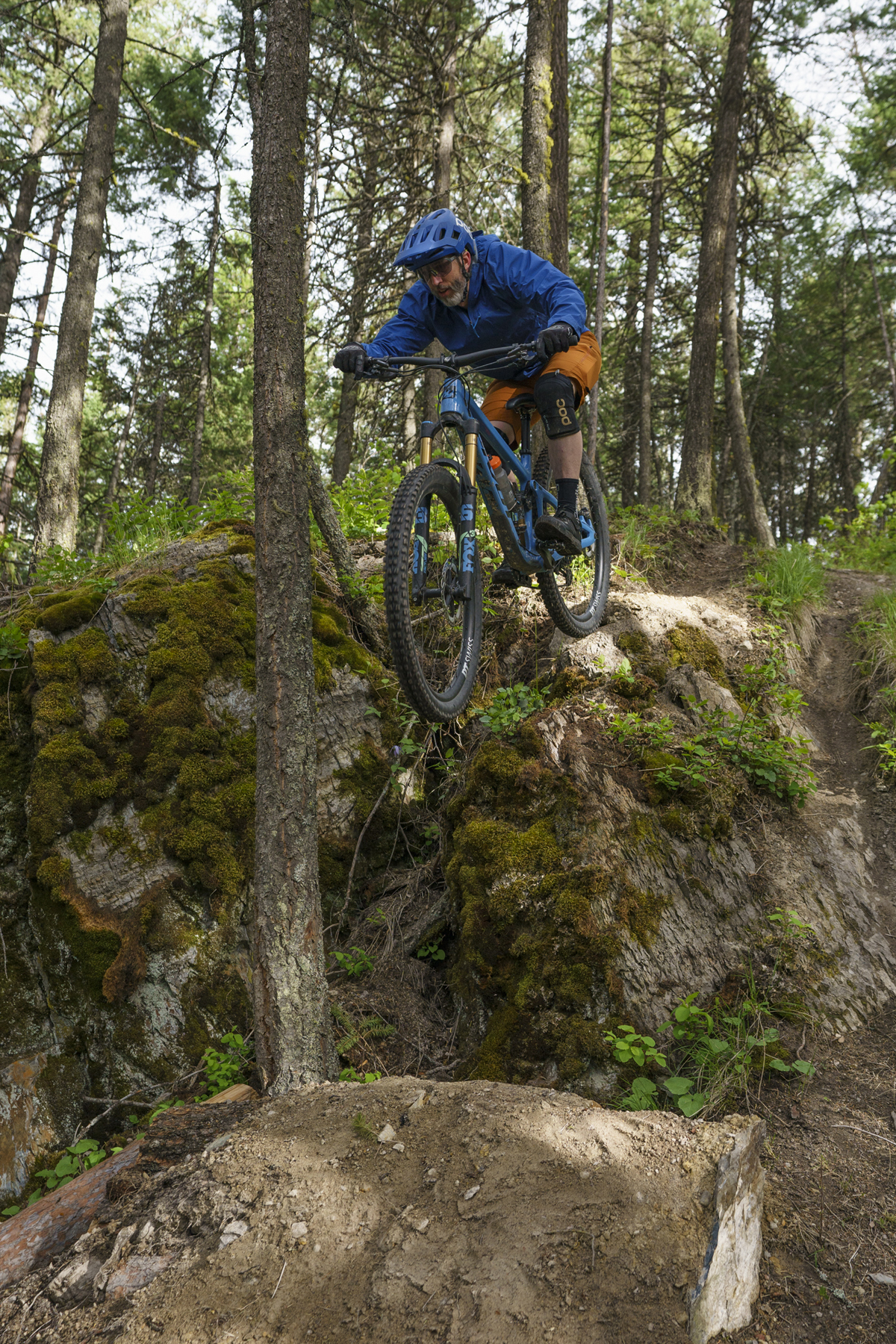
On rougher trails, the suspension errs on the more supportive side — it doesn’t erase every little bump, but it feels effective. Particularly on large hits, I was impressed at how well the rear end created a soft landing.
I found the short rear end to be the most noticeable quirk — it requires a bit more attention to get the right weight distribution through corners. On the bikes that fit me the best, I find that I can stand in a very centered, neutral position, lean the bike over, and the wheels will track nicely around the corner. On the Switchblade, to get the bike to track smoothly around a corner required a more forward position, and I found the sweet spot for that position to be somewhat narrow.
The Switchblade is a stiffer frame than most other bikes I’ve ridden in this class, and that combined with a supportive rear shock and a short rear end makes for a bike that pumps, pops, and jumps really well. It’s one of the better jumping 29ers in this class that I’ve been on in recent memory, and the bike just begs to be thrown into berms with reckless abandon.
That stiff frame is a double-edged sword though — while the bike pumps and pops well and feels very precise, it’s also relatively unforgiving. I had a harder time getting the Switchblade to track cleanly through longer, higher-speed rock gardens and rooty sections, where it tended to get bounced off line. And while the Switchblade’s suspension is good at making up for my mistakes, getting bounced off line rarely feels smooth or fast. I found this particular trait to be pretty interesting — I’ve ridden and reviewed plenty of bikes that I found to be a bit too flexy, particularly in the rear end. The Switchblade is one of a very small number of bikes where I think I might prefer a little more flex. However, this also might mean bigger riders (I’m about 170 lbs) will find it to be just right.
On the whole, I had the most fun on the Switchblade on flowier trails where I could capitalize on the bike’s penchant for popping and carving. I also enjoyed it on slower speed, more technical trails. It feels very precise, and that same supportiveness that helps it pump and pop also means it feels responsive when the trail calls for some pseudo-Trials maneuvers. For higher speed, rougher trails, I certainly wouldn’t call the Switchblade bad, but there are other bikes in this class that are longer, slacker, and less inclined to get bounced off line that win out in those situations.
My day-to-day personal bike, a Transition Sentinel, is a useful point of comparison. The Sentinel has a little more travel in the rear than the Switchblade (142 mm on the Switchblade, 150mm on the Sentinel; both run 160mm forks), but both bikes are marketed as aggressive Trail / light-duty Enduro bikes. (It’s also worth noting that my Sentinel is a Large, but nominal sizing notwithstanding, the fit feels fairly comparable between the two.)
The Sentinel is much slacker (63.6° head angle vs 65.2° on the Switchblade), the chainstays are longer (440 mm on the Sentinel vs 431 mm on the Switchblade), and the wheelbase is considerably longer (1263 mm for the Large Sentinel vs. 1223 mm for the Medium Switchblade. A Large Switchblade grows to 1242 mm). All of that makes the Sentinel feel considerably more stable at higher speeds, and considerably less maneuverable at lower speeds.
The Switchblade is also a significantly stiffer frame than the Sentinel. Through rock gardens, the Sentinel tends to wiggle through and find a workable line whereas the Switchblade tends to get bounced around and struggle to carry speed. Conversely, in hard compressions and when railing berms, the Sentinel feels more noodley and vague, whereas the Switchblade feels composed and precise. Frame stiffness aside, the Switchblade’s suspension handles big impacts better, and it’s noticeably more efficient. The Sentinel does a better job of smoothing out small to mid-size bumps.
On the whole, if I’m riding a jumpy, bermy flow Trail, I’d pick the Switchblade. I’d also take the Switchblade for pretty much any climb. If I’m tasked with going fast down natural trails that are rooty and rocky, I’d take the Sentinel.
The Build
Pivot offers the Switchblade with eight different build kits as well as three kits in the “Talon” version, which is a limited edition hot pink release that’s a throwback to Pivot founder Chris Cocalis’s first bike build — the 1989 Sun Eagle Talon.
Build kits start with a $6,399 SLX / XT build, and go all the way up to the $11,599 Talon Team XX AXS Transmission. I rode the $8,999 Pro XT/XTR build with the carbon wheel upgrade, which hits a fairly nice middle-of-the-road sweet spot (to the extent you can call a $9,000 bike middle-of-the-road). The same build kit can be had with aluminum wheels for $7,799, which would probably be my pick for bang for the buck, although all of the builds come with a decidedly high-end price tag.

The build on my test bike is primarily XT, but with the bump up to an XTR rear derailleur. This seems like a good choice to me as I’ve found XTR derailleurs to both shift better and be a bit more durable than XT. Shifting on the bike was flawless throughout my time on it — I have nothing whatsoever to complain about. The XT brakes paired with Ice-Tech rotors (203 front, 180 rear) performed exactly as expected — good power, good lever feel, and an occasionally wandering bite point that I find utterly infuriating.
Suspension is handled by Fox, with a 160mm Fox 36 Factory Grip 2 up front, and a Float X Factory producing 142 mm of travel out back. These are well known, consistent performers — they worked well for me on the Switchblade, just as they’ve worked well for me on every other bike where I’ve used them.
The carbon-wheeled version of the Pro XT/XTR build that I rode features the DT Swiss XMC1501, which uses a 30 mm carbon rim laced to a 240 hub with a 36t star ratchet. The aluminum-wheeled version of this build bumps down to a still-pretty-nice DT Swiss XM1700 wheelset with 350 hubs. XMC1501s were almost everything I’d want out of a Trail wheelset — they’re light, they’re reasonably stiff, and they didn’t go out of true whatsoever in my time on them. My only complaint? The spokes creak a little bit on steep climbs, but that was minimal enough to likely only bother the most finicky of riders.
The biggest issue I had was the creaky bottom bracket, which I failed to remedy via the time honored method of taking everything apart, cleaning it, and putting it back together. In all likelihood, pressing in a fresh bottom bracket would resolve the issue, but regardless, it’s not ideal — especially in a world where many other manufacturers have gone back to threaded bottom brackets.
Who’s It For?
The newest version of the Switchblade gets some iterative changes, but it’s still very much a Pivot, meaning that it pedals well and has what I’d call “conservatively modern” geometry. I found it to be happiest pumping, jumping, and carving around on flowy trails. It’s entirely capable of plowing into chunkier, rocky tech, but the combination of more conservative geometry and a stiff frame required a bit more attention. That said, the suspension does a nice job of accommodating my mistakes.
The Switchblade does a decent job of straddling the line between a bike built around climbing and a slacker long and low Enduro-y sled. I’d particularly recommend it to people whose everyday trails are tighter and techier, and also to bigger riders that will appreciate the stiffer frame.
Bottom Line
All in all, the Switchblade feels like a modern take on a traditionalist’s Trail bike. It doesn’t have the slacked out angles and long rear end of the more progressive options on the market, which means it’s an easier bike to manage in slower-speed tech and tighter situations. But paired with those attributes is a longer travel (by Trail bike standards) fork and rear suspension that’s a bit more forgiving than some of the shorter travel, more uphill-oriented Trail bikes.
And as always, if you’re curious about how the Switchblade stacks up against another bike, or want our take on how it would work for you and your preferences, BLISTER+ Members can drop us a line through the form in the Blister Member’s Clubhouse and we’ll talk things through with you.

The usual excellent write up, Noah. Pivot makes such lovely bikes. It’s too bad Chris C has dug his heels in so deep on the Superboost nonsense.
And I don’t get it, as I’ve got a few “regular” Boost Treks that will fit a 2.6 with room to spare, it that’s what you want to run.